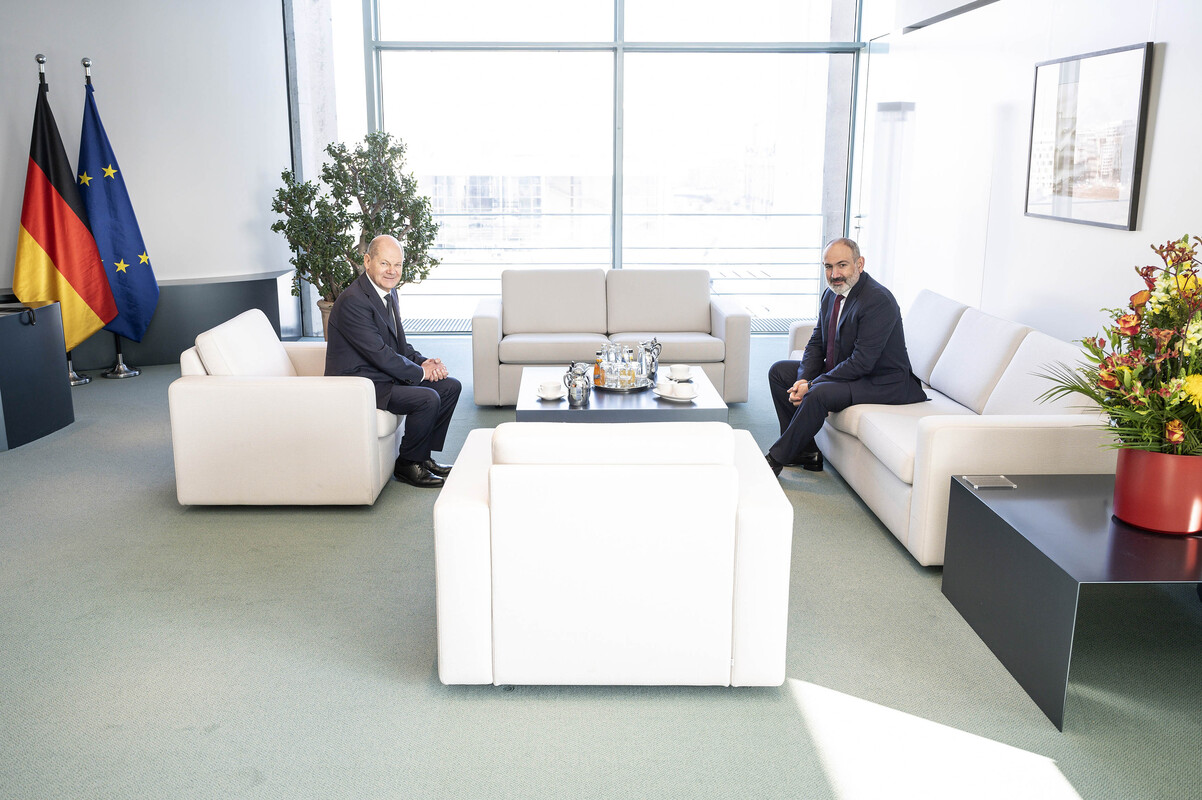
At a time when the tension between Ukraine and Russia has increased and news reports about Russian military build-up along the Ukrainian border is making headlines, a recently published statement (8 April) by the Russian Defence Ministry Southern Military District on 8 April 2021 has attracted attention.[1] According to the statement, Russia has moved 10 navy vessels from its Caspian Flotilla to the Black Sea Fleet that is responsible for the Black Sea, the Sea of Azov, and the Mediterranean Sea to take part in the mass military drills.[2] It is understood from the statement that navy vessels are comprised of landing crafts and artillery boats (schmel class gunboats) that departed from their Caspian base in the city of Makhachkala [Mahaçkale in Dağıstan]. It is mentioned in the statement that before leaving the base, the crews of the navy vessels completed the full cycle of basic training and courses regarding the tasks at sea. In preparation for the passage to the Black Sea, the boat commanders, watch officers and crew, for navigational safety, also completed trainings on the passage of narrow sections of the canals and flowing zones. It is stated that drills will focus on testing the "readiness to repel sea and airborne assault forces."[3]
How does Russia transfer naval vessels from the Caspian Sea to the Black Sea?
At the European side of its territory, Russia has a well-organized unified deep water inland waterway network. This network links the White Sea, the Baltic Sea, the Volga, the Caspian Sea, and the Sea of Azov to the Black Sea. According to knowledgeable sources, the depth throughout the network is not less than 4.5 meters, allowing passage through it not only by river vessels and river-sea class but by many sea-going vessels, warships, and even nuclear submarines (while on the surface).[4]
As longest river in Europe, the Volga River can be considered as the backbone of this network. It flows from Central Russia to Southern Russia and the Caspian Sea. Another important river is the Don, Europe's fifth longest river, which flows from Central Russia into the Sea of Azov in Southern Russia. The Ottoman Turks were the first in history to attempt to connect the Volga and Don rivers via a canal back in 1569 to unite the Black Sea and the Caspian.[5] According to most historians, the Ottomans managed to dig one-third of the canal. After several attempts to build such a canal in the following centuries, the Volga-Don canal opened in 1952 and the two seas were connected through which Russian vessels obtained the ability to navigate from Caspian Sea up to the Volga River, then through the canal cross the Don River and reach the Sea of Azov and the Black Sea. By effectively using these waterways, Russia, as in the latest case, can reinforce its Black Sea Navy at any time with gunboats and landing crafts from its Caspian Flotilla and vice a versa.
Efforts to reach the Black Sea through the military use of the Danube River
The Danube is Europe's second-longest river after the Volga, flowing through much of Central and Southeastern Europe, from the Black Forest into the Black Sea. After Russia's annexation of Crimea in 2014, in the context of efforts to strengthen NATO's presence in the Black Sea, some "creative" ideas were brought to the agenda in addition to sending NATO military vessels through the Turkish Straits to the Black Sea within the framework of the 1936 Montreux Straits Convention. The Montreux Convention Regarding the Regime of the Straits, as is well known gives Turkey control over the Turkish Straits of the Bosporus and Dardanelles and regulates the transit of military vessels. The Convention guarantees the free passage of civilian vessels in peacetime, restricts the passage of military vessels not belonging to the Black Sea states and permits these military vessels to stay in the Black Sea for no longer than twenty-one days. In this context, as noted earlier, “creative ideas” for circumventing these restrictions were brought to fore. The use of the Danube for military purposes was one of them. The “German option” was suggested within this context.[6]
According to this option, Article 30 of the 1948 Convention Regarding the Regime of Navigation on the Danube gives permission only to Danubian countries to operate military vessels in the Danube River. However, if a Danubian country wants to enter a stretch of the Danube River falling outside its territorial jurisdiction, then it must first get the permission of the relevant Danubian state. The only Danubian country that is not the Black Sea coastal state, but still has a navy, is Germany. Therefore, if Romania invites Germany into its section of the Danube River, according to this option, “it would allow the German Navy [to] reset the clock on the 21-day limit” stipulated by the Montreux Convention. It is mentioned in this regard that Germany sent just one ship — a 3,500-ton Elbe-class tender (support ship) — into the Black Sea for a total of 18 days in 2019.
The terminology used in these "creative ideas" to boost the NATO presence in the Black Sea is "to get around these restrictions", which means the restrictions stipulated by the Montreux Convention. It is possible to say that this terminology is disturbing and is meant to circumvent the legally binding agreements by going through the back door. If one wants to circumvent the Montreux Convention with these creative ideas, much more severe consequences may be encountered instead of the expected benefits. For example, by bringing a gunboat to the Black Sea in this way, it can be encountered with ten times more gunboat power.
Although it has been 86 years since the Montreux Convention was signed in 1936, the Convention has maintained its validity and importance throughout those years. It continues to serve as the security valve for regional and global security.[7] To preserve stability and security in the Black Sea, it is important that the provisions of this convention are meticulously preserved in the upcoming period. Turkey has the capability and the means to keep the security and stability in balance in the region. Trying to upset this balance with “creative” backdoor tactics will not benefit stability and security, neither in the Black Sea region nor in Europe.
*Photo: The Drive and South Front
[1] “Десантные и артиллерийские катера Каспийской флотилии приступили к межфлотскому переходу,” Министерство обороны Российской Федерации (Минобороны России), April 8, 2021, sec. Новости, https://function.mil.ru/news_page/country/more.htm?id=12353278@egNews.
[2] Katya Golubkova and Timothy Heritage, “Russia Moves Warships to Black Sea for Drills: Interfax,” Reuters, April 8, 2021, sec. Aerospace and Defense, https://www.reuters.com/article/us-ukraine-crisis-russia-defence-idUSKBN2BV14M.
[3] Josph Trevithick, “Russian Gunboats Head To The Black Sea To Join Military Buildup Near Ukraine,” The Drive, April 8, 2021, https://www.thedrive.com/the-war-zone/40103/russian-gunboats-head-to-the-black-sea-to-join-troop-buildup-near-ukraine.
[4] “Inland Waterways,” Global Security, sec. Military, accessed April 1, 2021, https://www.globalsecurity.org/military/world/russia/waterways.htm.
[5] Stanford J. Shaw, History of the Ottoman Empire and Modern Turkey: Volume 1, Empire of the Gazis: The Rise and Decline of the Ottoman Empire 1280–1808, 1st ed., vol. 1 (Cambridge: Cambridge University Press, 1976), 177.
[6] Luke Coffey, “To Boost NATO’s Presence in the Black Sea, Get Creative,” Defense One, May 30, 2020, sec. Ideas, https://www.defenseone.com/ideas/2020/05/increasing-natos-presence-black-sea-time-get-creative/165760/.
[7] Teoman Ertuğrul Tulun, The Montreux Convention: A Regional And Global Safety Valve, Report 17 (Ankara: Center for Euraisan Studies (AVİM), 2020), https://doi.org/10.6084/m9.figshare.11955780.v1.
© 2009-2025 Center for Eurasian Studies (AVİM) All Rights Reserved
No comments yet.
-
 BREXIT: NEW PARADIGM SHIFT FOR GLOBALIZATION AND SIGNAL FOR NEW WORLD ORDER
BREXIT: NEW PARADIGM SHIFT FOR GLOBALIZATION AND SIGNAL FOR NEW WORLD ORDER
Teoman Ertuğrul TULUN 27.01.2017 -
 NATO IS NOT BRAIN-DEAD: HOW CAN OSCE AND NATO HELP STOP THE WAR IN UKRAINE?
NATO IS NOT BRAIN-DEAD: HOW CAN OSCE AND NATO HELP STOP THE WAR IN UKRAINE?
Teoman Ertuğrul TULUN 08.03.2022 -
 GUARDIANSHIP OR EQUILIBRIUM? POWER, AND THE LEGACY OF ORDER IN THE BLACK SEA
GUARDIANSHIP OR EQUILIBRIUM? POWER, AND THE LEGACY OF ORDER IN THE BLACK SEA
Teoman Ertuğrul TULUN 02.09.2025 -
 DISGUISED INITIATIVES ON NAGORNO-KARABAKH IN EUROPEAN PARLIAMENT
DISGUISED INITIATIVES ON NAGORNO-KARABAKH IN EUROPEAN PARLIAMENT
Teoman Ertuğrul TULUN 20.02.2018 -
 1934 PACT OF BALKAN ENTENTE: THE PRECURSOR OF BALKAN/SOUTHEAST EUROPE COOPERATION
1934 PACT OF BALKAN ENTENTE: THE PRECURSOR OF BALKAN/SOUTHEAST EUROPE COOPERATION
Teoman Ertuğrul TULUN 06.08.2020
-
 PASHINYAN'S GERMANY VISIT
PASHINYAN'S GERMANY VISIT
Turgut Kerem TUNCEL 09.03.2023 -
 ROBERT FISK, BETWEEN FRANCOPHOBIA AND TURKOPHOBIA
ROBERT FISK, BETWEEN FRANCOPHOBIA AND TURKOPHOBIA
Maxime GAUIN 19.11.2015 -
 ARAKAN AND THE PLIGHT OF THE ROHINGYA: CONFLICT UNDER AN UMBRELLA OF DEFINITIONS
ARAKAN AND THE PLIGHT OF THE ROHINGYA: CONFLICT UNDER AN UMBRELLA OF DEFINITIONS
Teoman Ertuğrul TULUN 09.10.2017 -
 THE GRAIN INITIATIVE AND THE BLACK SEA SECURITY - I
THE GRAIN INITIATIVE AND THE BLACK SEA SECURITY - I
Turgut Kerem TUNCEL 03.08.2023 -
 TAIWAN’S SOVEREIGNTY AND “ONE CHINA” DILEMMA
TAIWAN’S SOVEREIGNTY AND “ONE CHINA” DILEMMA
Şevval Beste GÖKÇELİK 19.12.2022
-
25.01.2016
THE ARMENIAN QUESTION - BASIC KNOWLEDGE AND DOCUMENTATION -
12.06.2024
THE TRUTH WILL OUT -
27.03.2023
RADİKAL ERMENİ UNSURLARCA GERÇEKLEŞTİRİLEN MEZALİMLER VE VANDALİZM -
17.03.2023
PATRIOTISM PERVERTED -
23.02.2023
MEN ARE LIKE THAT -
03.02.2023
BAKÜ-TİFLİS-CEYHAN BORU HATTININ YAŞANAN TARİHİ -
16.12.2022
INTERNATIONAL SCHOLARS ON THE EVENTS OF 1915 -
07.12.2022
FAKE PHOTOS AND THE ARMENIAN PROPAGANDA -
07.12.2022
ERMENİ PROPAGANDASI VE SAHTE RESİMLER -
01.01.2022
A Letter From Japan - Strategically Mum: The Silence of the Armenians -
01.01.2022
Japonya'dan Bir Mektup - Stratejik Suskunluk: Ermenilerin Sessizliği -
03.06.2020
Anastas Mikoyan: Confessions of an Armenian Bolshevik -
08.04.2020
Sovyet Sonrası Ukrayna’da Devlet, Toplum ve Siyaset - Değişen Dinamikler, Dönüşen Kimlikler -
12.06.2018
Ermeni Sorunuyla İlgili İngiliz Belgeleri (1912-1923) - British Documents on Armenian Question (1912-1923) -
02.12.2016
Turkish-Russian Academics: A Historical Study on the Caucasus -
01.07.2016
Gürcistan'daki Müslüman Topluluklar: Azınlık Hakları, Kimlik, Siyaset -
10.03.2016
Armenian Diaspora: Diaspora, State and the Imagination of the Republic of Armenia -
24.01.2016
ERMENİ SORUNU - TEMEL BİLGİ VE BELGELER (2. BASKI)
-
AVİM Conference Hall 24.01.2023
CONFERENCE TITLED “HUNGARY’S PERSPECTIVES ON THE TURKIC WORLD"









